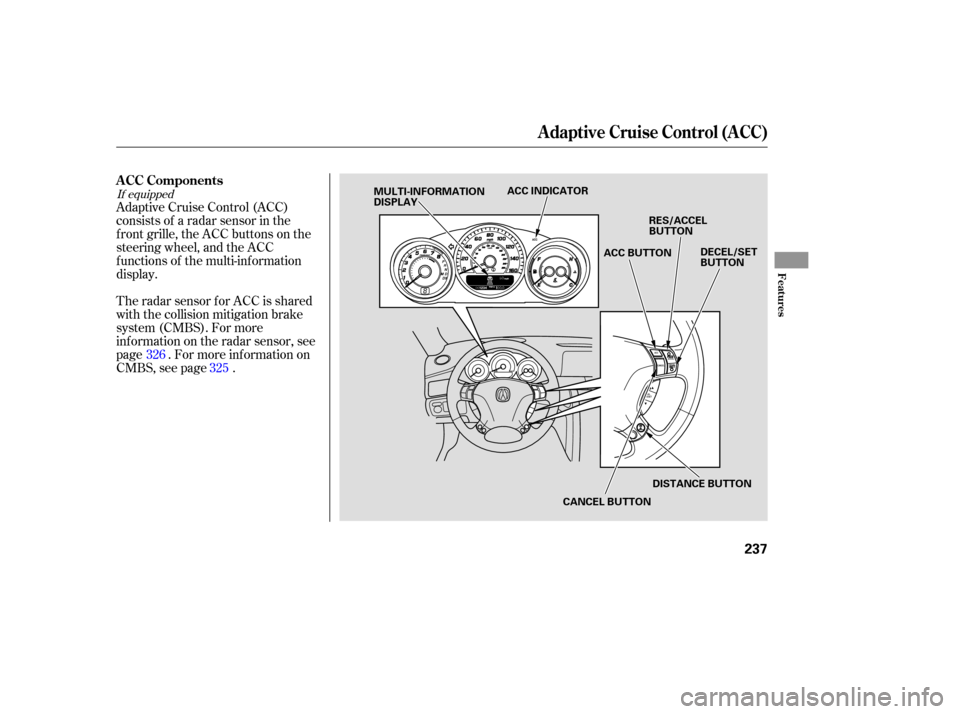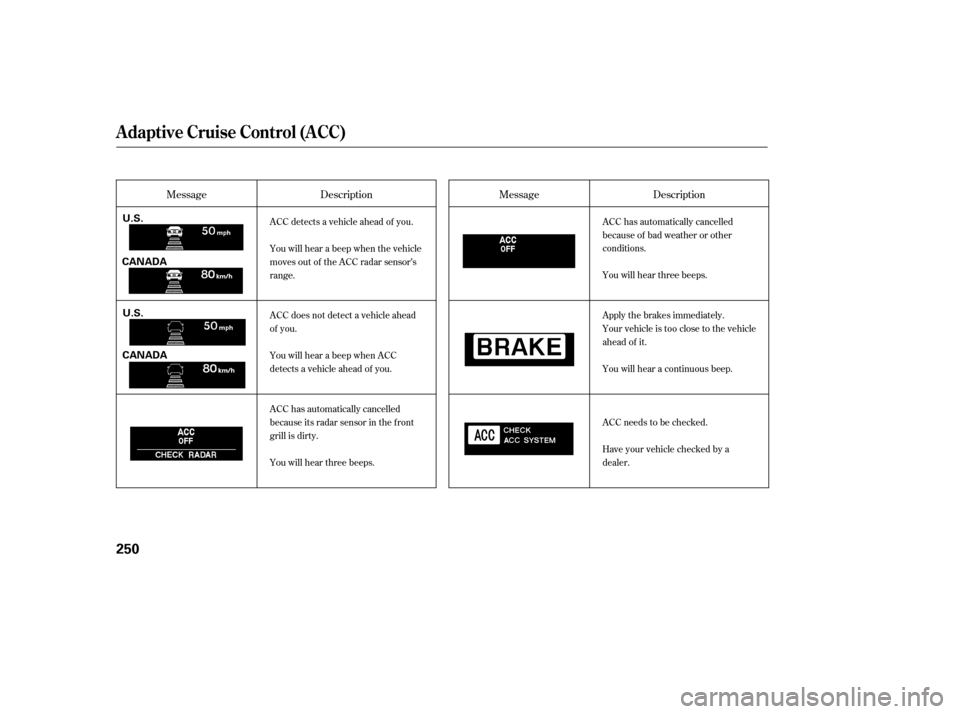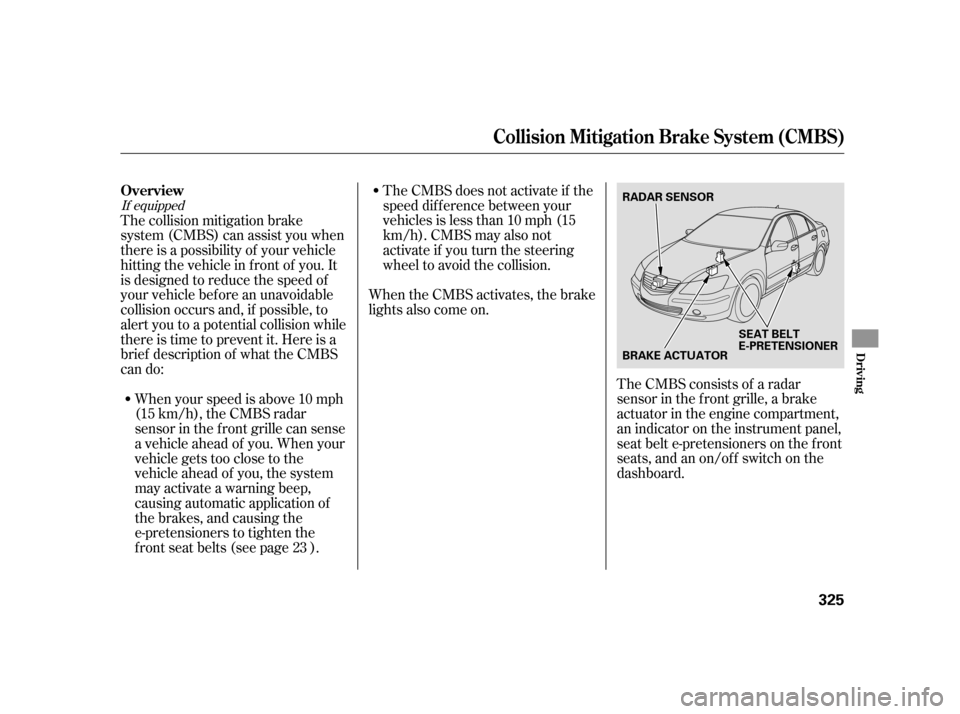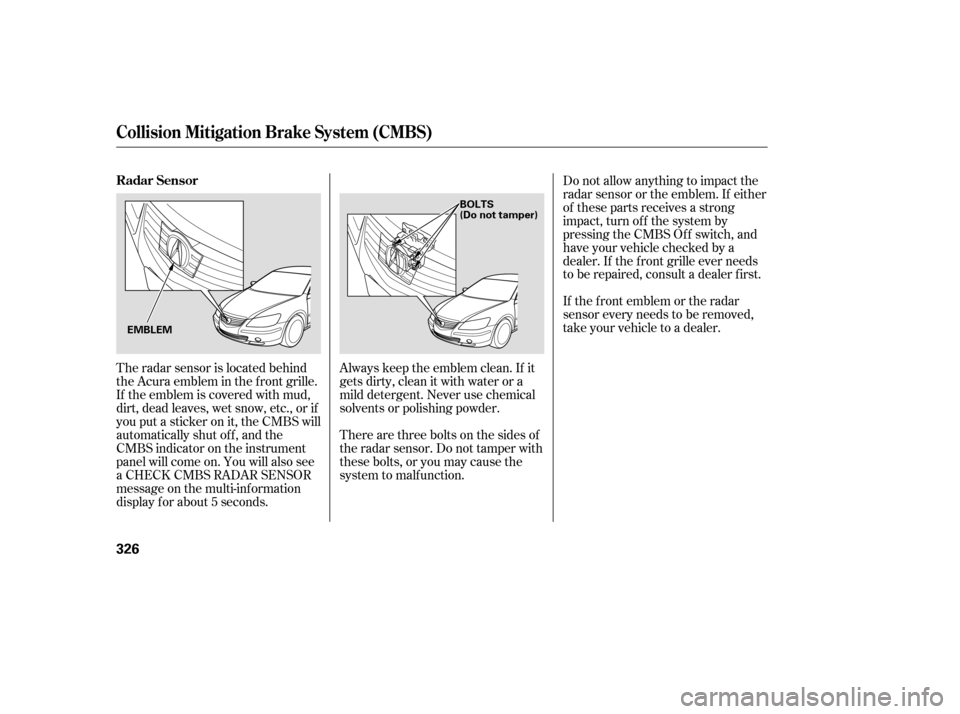sensor Acura RL 2006 Owner's Guide
[x] Cancel search | Manufacturer: ACURA, Model Year: 2006, Model line: RL, Model: Acura RL 2006Pages: 454, PDF Size: 5.58 MB
Page 194 of 454

The standard audio system has
many f eatures. This section de-
scribes those f eatures and how to
use them. The climate control system in your
vehicle provides a comfortable
driving environment in all weather
conditions.
Theclimatecontrolsystemandthe
audio system have a voice control
feature. Refer to the navigation
system manual f or more inf ormation.
Your vehicle has an anti-theft audio
system that requires a code number
to enable it.
The security system helps to
discourage vandalism and thef t of
your vehicle.Vents, Heating, A/C, and Climate
.......................................
Control .194
..............
Climate Control Sensors .202
................................
Audio System .203
..........
Playing the AM/FM Radio .204
............
AM/FM Radio Reception .208
.....................
Adjusting the Sound .210
Playing the XM
Satellite
..........................................
Radio .213
.................................
Playing Discs .219
..................
Protecting Your Discs .228
...
Disc Changer Error Messages .229
................
Remote Audio Controls .230
................
Radio Thef t Protection .232
............................
Security System .233
...............................
Cruise Control .234
..
Adaptive Cruise Control (ACC) .237
HomeLink Universal
................................
Transceiver .252
......................................
AcuraLink .256
............................................
OnStar .265
..........................
HandsFreeLink .278
Features
Features
193
TM
Page 203 of 454

Theclimatecontrolsystemhastwo
sensors. A sunlight sensor is in the
top of the dashboard, and a
temperature sensor is next to the
steering column. Do not cover the
sensors or spill any liquid on them. Sunlight and T emperature
Sensors
Climat e Cont rol Sensors
202
SUNLIGHT SENSORTEMPERATURE SENSOR
Page 238 of 454

The radar sensor for ACC is shared
with the collision mitigation brake
system (CMBS). For more
inf ormation on the radar sensor, see
page . For more inf ormation on
CMBS, see page . Adaptive Cruise Control (ACC)
consists of a radar sensor in the
f ront grille, the ACC buttons on the
steering wheel, and the ACC
f unctions of the multi-inf ormation
display.325
326
If equipped
A daptive Cruise Control (A CC)
A CC Components
Features
237
ACC INDICATOR
MULTI-INFORMATION
DISPLAY
RES/ACCEL
BUTTON
ACC BUTTON
DISTANCE BUTTON
CANCEL BUTTON DECEL/SET
BUTTON
Page 239 of 454

Adaptive cruise control (ACC) allows
you to maintain a set speed and keep
the vehicle ahead of you at a safe
distance without having to use the
accelerator pedal or the brake pedal.
When the vehicle ahead of you slows
down or speeds up, ACC senses the
change in distance and compensates
by accelerating or braking your
vehicle to reach the cruising speed
you previously set. The distance
between vehicles is based on your
speed: the f aster you go, the longer
the distance will be; the slower you
go, the shorter it will be.If the vehicle ahead of you slows
down or speeds up suddenly, ACC
alerts you by sounding a beeper and
displaying a message on the multi-
inf ormation display.
TheACCradarsensorinthefront
grille can detect and monitor the
distance of a vehicle up to 328 f eet
(100 meters) ahead of your vehicle.
For more inf ormation on the radar
sensor, see page .
Do not use ACC under these
conditions:
In poor visibility.
In heavy traffic.
When you must slow down and
speed up repeatedly.
On winding roads.
When you enter a toll gate,
interchange, service area, parking
area, etc. In these areas, there is
no vehicle ahead of you, but ACC
would still try to accelerate to your
set speed.
In bad weather (rain, f og, snow,
etc.)
On a slippery road (f or example a
road covered with ice or snow).
As with any system, there are limits
to ACC. Inappropriate use of ACC
can result in a serious accident. Use
the brake pedal whenever necessary,
and always keep a safe distance
between your vehicle and other
vehicles. 326
A daptive Cruise Control (A CC)
Overview
Important Saf ety Precautions
238
Page 249 of 454

This indicator normally comes on f or
a f ew seconds when you turn the
ignition switch to the ON (II)
position. If it comes on at any other
time, there is a problem in the ACC
system. If this happens, take the
vehicle to your dealer to have it
checked.
The ACC system cannot be used
while this indicator is on.
When ACC is automatically
cancelled, the beeper sounds three
times, and an ACC OFF message
appears on the multi-inf ormation
display f or 3 seconds.
Any of these conditions may cause
ACC to cancel:
The vehicle speed decreases
below22mph(35km/h). Driving on a mountainous road, or
driving of f road f or extended
periods.
When the VSA indicator comes on. When the ABS or VSA is activated.
Abrupt steering wheel movement.
If ACC is cancelled by any these
conditions, wait until the condition
improves, then press the RES/
ACCEL button to restore ACC.
When you do this, the vehicle will
resume its set cruising speed.
If you turn the ignition switch to the
ACCESSORY (I) or the LOCK (0)
position af ter ACC was automatically
cancelled, the set speed is erased,
and you must enter it again (see
page ).
Poor weather (rain, f og, snow, etc.)
When the radar sensor in the front
grill gets dirty.
The vehicle ahead of you cannot
be detected.
An abnormal tire condition is
detected, or the tires are skidding.242
A daptive Cruise Control (A CC)
Automatic ACC Cancellation
ACC Indicator
248
ACC INDICATOR
Page 251 of 454

MessageMessage
Description Description
ACC detects a vehicle ahead of you.
You will hear a beep when the vehicle
moves out of the ACC radar sensor’s
range.
ACC does not detect a vehicle ahead
of you.
You will hear a beep when ACC
detects a vehicle ahead of you.
ACC has automatically cancelled
because its radar sensor in the f ront
grill is dirty.
You will hear three beeps. ACC has automatically cancelled
because of bad weather or other
conditions.
You will hear three beeps.
Apply the brakes immediately.
Your vehicle is too close to the vehicle
ahead of it.
You will hear a continuous beep.
ACC needs to be checked.
Have your vehicle checked by a
dealer.
A daptive Cruise Control (A CC)
250
U.S.
U.S.
CANADA
CANADA
Page 326 of 454

The CMBS does not activate if the
speed dif f erence between your
vehicles is less than 10 mph (15
km/h). CMBS may also not
activate if you turn the steering
wheel to avoid the collision.The CMBS consists of a radar
sensor in the f ront grille, a brake
actuator in the engine compartment,
an indicator on the instrument panel,
seat belt e-pretensioners on the f ront
seats,andanon/off switchonthe
dashboard.
When the CMBS activates, the brake
lights also come on.
The collision mitigation brake
system (CMBS) can assist you when
there is a possibility of your vehicle
hitting the vehicle in f ront of you. It
is designed to reduce the speed of
your vehicle before an unavoidable
collision occurs and, if possible, to
alert you to a potential collision while
thereistimetopreventit.Hereisa
brief description of what the CMBS
can do:
When your speed is above 10 mph
(15 km/h), the CMBS radar
sensor in the f ront grille can sense
a vehicle ahead of you. When your
vehicle gets too close to the
vehicle ahead of you, the system
mayactivateawarningbeep,
causing automatic application of
the brakes, and causing the
e-pretensioners to tighten the
f ront seat belts (see page ). 23
If equipped
Collision Mitigation Brake System (CMBS)
Overview
Driving
325
RADAR SENSOR
BRAKE ACTUATORSEAT BELT
E-PRETENS
IONER
Page 327 of 454

The radar sensor is located behind
the Acura emblem in the f ront grille.
If the emblem is covered with mud,
dirt, dead leaves, wet snow, etc., or if
you put a sticker on it, the CMBS will
automatically shut off, and the
CMBS indicator on the instrument
panel will come on. You will also see
a CHECK CMBS RADAR SENSOR
message on the multi-inf ormation
display f or about 5 seconds.Always keep the emblem clean. If it
gets dirty, clean it with water or a
mild detergent. Never use chemical
solvents or polishing powder.Do not allow anything to impact the
radar sensor or the emblem. If either
of these parts receives a strong
impact, turn off the system by
pressing the CMBS Of f switch, and
have your vehicle checked by a
dealer. If the f ront grille ever needs
to be repaired, consult a dealer f irst.
There are three bolts on the sides of
the radar sensor. Do not tamper with
these bolts, or you may cause the
system to malf unction. If the f ront emblem or the radar
sensor every needs to be removed,
take your vehicle to a dealer.
Collision Mitigation Brake System (CMBS)
Radar Sensor
326
EMBLEM
BOLTS
(Do not tamper)
Page 328 of 454

When the CMBS is on, the radar
sensor constantly scans f or vehicles
ahead of you. This means that
driving on a road with a f ew or no
vehicles could cause a CHECK
CMBS RADAR SENSOR message to
appear on the multi-inf ormation
display. This is normal and not a
cause f or concern.The radar sensor may not always
scan as intended. Here are two
examples:
Thetiresarenotcorrectly
maintained. Always make sure the
tire pressures are correct (see
page ), and that the tires are
the correct size and in good
condition (see Tires on page ). Your vehicle is tilted because of a
heavy load in the rear or from
modif ications to the suspension.
Do not overload your vehicle (see
Carrying Cargo on page ), and
do not make any modif ications to
the suspension (see Accessories
and Modif ications on page ). 305
303
384 384
Collision Mitigation Brake System (CMBS)
Driving
327
Page 336 of 454

Your vehicle is equipped with a tire
pressure monitoring system (TPMS)
that turns on every time you start the
engine and monitors the pressure in
your tires while driving.
Each tire has its own pressure
sensor. If the air pressure of a tire
becomes signif icantly low, the
sensor in that tire immediately sends
a signal that causes the low tire
pressure indicator in the
instrumental panel and the
appropriate tire position indicator on
thetirepressuremonitoronthe
multi-inf ormation display (see page)tocomeon. For example, if you check and f ill
your tires in a warm area, then drive
in extremely cold weather, the tire
pressure will be lower than
measured and could be underinflated
and cause the low tire pressure
indicator to come on. Or, if you
check and adjust your tire pressure
in cooler conditions, and drive into
extremely hot conditions, the tire
maybecomeoverinflated.However,
the low tire pressure indicator will
not come on if the tires are
overinf lated.
When the low tire pressure indicator
is on, one or more of your tires is
signif icantly underinf lated. The
multi-inf ormation display also shows
a ‘‘CHECK TIRE PRESSURE’’
message (see page ). You should
stop and check your tires as soon as
possible, and inflate them to the
proper pressure as indicated on the
vehicle’s tire inf ormation placard.
Driving on a signif icantly under-
inf lated tire causes the tire to
overheat and can lead to tire failure.
Under-inf lation also reduces f uel
efficiency and tire tread life, and may
af f ect the vehicle’s handling and
stopping ability.
Becausetirepressurevariesby
temperature and other conditions,
the low tire pressure indicator may
come on unexpectedly.
Refer to page for tire inflation
guidelines.
383
336 335
CONT INUED
Low Tire Pressure
Indicator
Tire Pressure Monitoring System (TPMS)
Driving
335